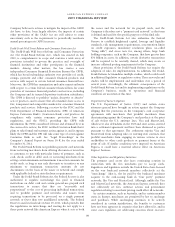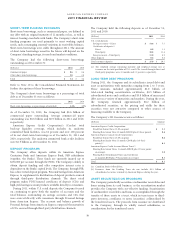American Express 2011 Annual Report Download - page 25
Download and view the complete annual report
Please find page 25 of the 2011 American Express annual report below. You can navigate through the pages in the report by either clicking on the pages listed below, or by using the keyword search tool below to find specific information within the annual report.
AMERICAN EXPRESS COMPANY
2011 FINANCIAL REVIEW
Assuming no changes in foreign exchange rates, total billed
business outside the United States grew 18 percent in Japan, Asia
Pacific and Australia, 14 percent in Latin America and Canada,
and 8 percent in Europe, the Middle East and Africa during
20112.
During 2010, discount revenue increased $1.7 billion or 13
percent to $14.9 billion compared to 2009 as a result of a 15
percent increase in worldwide billed business and a slightly
higher average discount rate. The lower revenue growth versus
total billed business growth reflects the relatively faster billed
business growth rate of 28 percent related to GNS, where
discount revenue is shared with card-issuing partners, and higher
contra-revenues, including cash-back rewards costs and
corporate incentive payments. The 15 percent increase in
worldwide billed business in 2010 reflected an increase in
proprietary billed business of 13 percent.
Travel commissions and fees increased $198 million or 11
percent to $2.0 billion in 2011 compared to 2010, primarily
reflecting a 13 percent increase in worldwide travel sales. Travel
commissions and fees increased $182 million or 11 percent to
$1.8 billion in 2010 compared to 2009, primarily reflecting a 19
percent increase in worldwide travel sales, partially offset by
lower pricing.
Other commissions and fees increased $238 million or 12
percent to $2.3 billion in 2011 compared to 2010, primarily
driven by revenues related to Loyalty Partner. Other
commissions and fees increased $253 million or 14 percent to
$2.0 billion in 2010 compared to 2009, driven primarily by new
GAAP governing consolidations and VIEs where fees related to
securitized receivables are recognized as other commissions and
fees beginning 2010. These fees were reported in net
securitization income in 2009 and prior periods. The increase
also reflects greater foreign currency conversion revenues related
to higher spending, partially offset by lower delinquency fees in
the non-securitized cardmember loan portfolio.
Net securitization income decreased $400 million to nil in
2010 compared to 2009, as the Company no longer reports net
securitization income, in accordance with new GAAP governing
consolidations and VIEs.
Other revenues in 2011 increased $237 million or 12 percent to
$2.2 billion compared to 2010, primarily reflecting higher GNS
partner-related royalty revenues, a contractual payment from a
GNS partner and greater merchant-related fee revenues. Other
revenues in 2010 decreased $163 million or 8 percent to $1.9
billion compared to 2009, primarily reflecting the $211 million
gain on the sale of 50 percent of the Company’s equity holdings
in ICBC in 2009, lower insurance premium revenues and higher
partner investments reported as a contra-other revenue, partially
offset by higher GNS partner-related royalty revenues, greater
merchant fee-related revenue and higher publishing revenue.
Interest income decreased $331 million or 5 percent to $7.0
billion in 2011 compared to 2010. Interest and fees on loans
decreased $246 million or 4 percent, driven by a lower net yield
2Refer to footnote 1 on page 21 under Consolidated Results of Operations for
the Three Years Ended December 31, 2011 relating to changes in foreign
exchange rates.
on cardmember loans, partially offset by a slight increase in
average cardmember loans. The lower net yield reflects lower
revolving levels and lower balances at penalty rates due to the
implementation of elements of the CARD Act and improved
credit performance. These reductions to yield were partially
offset by the benefit of certain repricing initiatives effective
during 2009 and 2010. Interest and dividends on investment
securities decreased $116 million or 26 percent, primarily
reflecting decreased levels of investment securities. Interest
income from deposits with banks and other increased $31
million or 47 percent, primarily due to higher average deposit
balances versus the prior year. Interest income increased $2.0
billion or 37 percent to $7.3 billion in 2010 compared to 2009.
Interest and fees on loans increased $2.3 billion or 52 percent,
driven by an increase in the average loan balance resulting from
the consolidation of securitized receivables beginning January 1,
2010, in accordance with new GAAP governing consolidations
and VIEs. Interest income related to securitized receivables was
reported in net securitization income in 2009 and prior periods,
but beginning January 1, 2010, is reported in interest and fees on
loans. The increase related to this consolidation was partially
offset by a lower yield on cardmember loans, reflecting higher
payment rates and lower revolving levels, and the
implementation of elements of the CARD Act. These reductions
to yield were partially offset by the benefit of certain repricing
initiatives effective during 2009 and 2010. Interest and dividends
on investment securities decreased $361 million or 45 percent,
primarily reflecting the elimination of interest on retained
securities in 2010 driven by new GAAP governing consolidations
and VIEs and lower short-term investment levels. Interest
income from deposits with banks and other increased $7 million
or 12 percent primarily due to higher average deposit balances
versus the prior year.
Interest expense decreased $103 million or 4 percent to $2.3
billion in 2011 compared to 2010. Interest expense related to
deposits decreased $18 million or 3 percent to $528 million, as
lower funding costs were partially offset by an increase in average
deposit balances. Interest expense related to long-term debt and
other decreased $93 million or 5 percent, reflecting lower average
long-term debt balances, partially offset by higher effective
funding costs. Interest expense increased $216 million or 10
percent to $2.4 billion in 2010 compared to 2009. Interest
expense related to deposits increased $121 million or 28 percent,
as higher customer balances were partially offset by a lower cost
of funds. Interest expense related to short-term borrowings
decreased $34 million or 92 percent, reflecting lower commercial
paper levels versus the prior year and a lower cost of funds.
Interest expense related to long-term debt and other increased
$129 million or 7 percent, reflecting the consolidation of long-
term debt associated with securitized loans previously held
off-balance sheet beginning January 1, 2010, in accordance with
new GAAP governing consolidations and VIEs. Interest expense
related to this debt was reported in net securitization income in
2009 and prior periods, but is reported in long-term debt and
other interest expense beginning January 1, 2010. The increase
was partially offset by lower average long-term debt.
23
























